Yorkshire Institution for the Education and Instruction of Deaf and Dumb Children, Doncaster
What became known as the Yorkshire Institution for the Education and Instruction of Deaf and Dumb Children resulted from the efforts of the Rev William Carr Fenton, the Rector of Cawthorpe, North Yorkshire. Fenton discovered that some deaf children in a poor Yorkshire family were having to travel to the London Asylum for the Deaf and Dumb to be educated because of the absence of any such facility in their home area. After visiting several existing establishments for teaching deaf children, he became convinced of the need to open one in Yorkshire. After much perseverance, he gained the support of such eminent figures as the Archbishop of York and the Earl of Harewood for the venture, and a public meeting was held at Doncaster on 10 March 1829 to take the matter forward. The meeting resolved that such an institution, to be located in the town, was desirable and rules were proposed for its government, which was to be by a committee of sixteen gentlemen. Perhaps not surprisingly, the Institution often referred to as the Doncaster School for the Deaf and Dumb.
A portion of Eastfield House, on Grandstand Road, Doncaster, was taken over the purpose and the Institution opened its doors on 2 November 1829, when eleven boys were admitted, followed by seven more a few weeks later. The following year, the committee were offered the whole of Eastfield House, together with three acres of land, for the sum of £3,000. Despite the larger part of the building having a sitting tenant, the sale was agreed and was finalised in 1831. In March 1830, to help raise the funds required for the purchase, the Institution began holding public examinations of its pupils in the larger towns in the county. Showing off the capabilities and attainments of the children, especially those from the places being visited, proved a very successful method of fund-raising and was adopted by similar institutions elsewhere in the country. In July 1830, twelve girls were admitted, taking the total number of pupils to 32, as many as could be accommodated. At the end of 1831, the lease of tenant of the other part of the house was purchased and in July 1832, an additional twenty pupils were admitted.
A typical public examination of the children was described in a newspaper report in July 1839.
Mr Baker, the Master of the Institution, proceeded with the examination of the children. He introduced four children in the lower class, who bad been in the institution ten months, and who, when they came in, were totally ignorant of the name of any object. Along with them was their teacher, a deaf and dumb girl, who had been six years in the institution. These children having observed the various signs made by the teacher, wrote the names of the corresponding objects with their plurals, on the blackboard. To this was added an exercise, shewing their acquaintance with adjectives and verbs; after which they proceeded to arithmetic, and performed sums in simple addition. The next class, who were examined by Joseph Widdop, a deaf and dumb teacher, took up the same exercise as the former on more advanced scale, as to the meaning of different words, their signification, qualities, use, &c. They were also examined in geography, by means of skeleton map, and having written the names of several towns as pointed out the teacher, gave a description of their situation, &c. thus — “Sheffield is in the West-Riding of Yorkshire, on the river Don, and is noted for cutlery.” Mr. Baker informed the meeting that this practice might be carried on throughout the whole map of England, and that it was only the same as their regular school lessons. After an examination in arithmetic, they were required to answer several questions on the historical facts of the Old and New Testaments; and were followed up in a still more advanced degree of the same departments by some pupils from the next class, who were examined by their teacher, Mr James Cook. In this, the concluding part of the examination, the pupils performed several sums in compound division and the more advanced rules of arithmetic; and throughout the whole proceedings scarcely a single mistake was made; and even if anything approaching to one were committed by pupil, it was instantly erased and corrected by another in the same class.
On 4 February 1863, the Institution was authorised to act as a Certified School, allowing it to receive pauper children boarded out from workhouses by the Poor Law authorities.
By the 1860s, the Institution was overflowing with pupils. In February 1864, the number of children in residence was 110, which was twenty more than could adequately be accommodated, with another twenty waiting for admission. Additions to the building planned, mainly for the boys' rooms and domestic facilities. The cost, including new fixtures and furniture, plus the renewal of many items that had been in use for the previous thirty years, was in the region of £2,800.
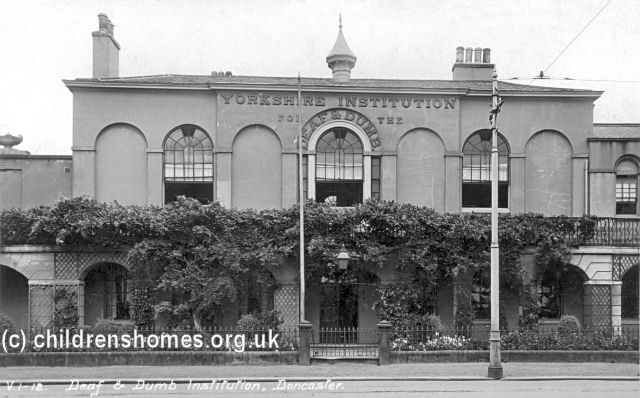
Yorkshire Institution for Deaf and Dumb Children, Doncaster, from the south-east c.1905. © Peter Higginbotham
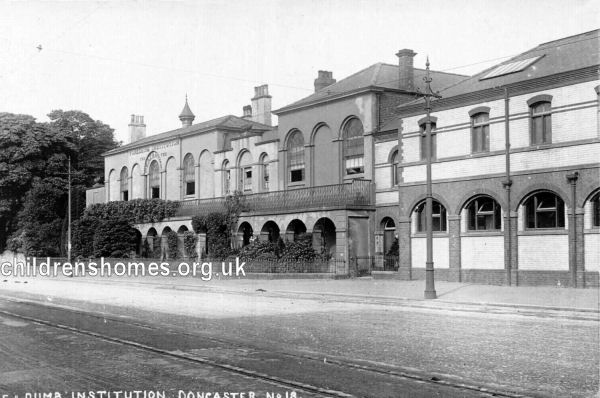
Yorkshire Institution for Deaf and Dumb Children, Doncaster, from the east, c.1905. © Peter Higginbotham
In its early years, teaching of the children in the Institution favoured the 'silent 'or 'manual' method, where communication was based on signing and finger-spelling. In 1877, after some experimentation, the 'oral' method, based on vocal articulation and lip-reading, was adopted.
The regulations for admission to the Institution were stated in 1890 as being:
By election. Candidates must be between the ages of 7 and 14 years. Applications must be sent in on a special form obtained from the Secretary or head master, by the first week in June. Before admission, a guarantee for payment of the fee must be signed by two responsible householders. Each subscription of 10s., and donation of £5, entitles subscriber or donor to recommend pupils for admission. The school is certified to receive paupers. Except as private boarders, London cases are not eligible; the school being confined to Yorkshire children, and upon certain conditions, children from Lincolnshire and Nottinghamshire. Payment, £9, and intermediate class £30 per annum, including board and education. No clothes are provided. The pupils are taught on the 'Pure Oral' system. Wood-carving is taught. Inmates must leave during the Midsummer vacation, optional at Christmas. Inmates remain until the age of 16. A fund exists for assisting country boys whilst learning a trade in a town. Private boarders are taken, by arrangement with head master.
In the 1890s, instruction in manual trade skills began to feature in the children's activities. For the boys, this began with cardboard modelling, then progressed to carpentry and carving, and later on bookmaking, mending, tailoring and gardening. The girls were taught cardboard work, domestic work, sewing and knitting, cutting out, cooking, laundry work and dressmaking. A greenhouse was built to encourage the boys' interest the boys in gardening. The manual work took place after school hours and children spent eight hours a week on it.
On 17 June 1902, the Bishop of Sheffield officially opened a new hall and ten classrooms, which had been erected over the previous year at a cost of about £3,400. The architect for the scheme was Mr J.G. Walker of Doncaster. At that date, the pupils numbered 119 —70 boys and 49 girls.
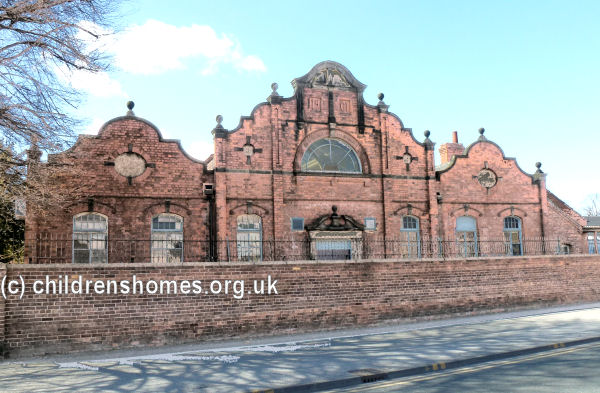
The 1901 block from the south-east, Yorkshire Institution for Deaf and Dumb Children, Doncaster, 2014. © Peter Higginbotham.
The Institution site in 1903 is shown on the map below.
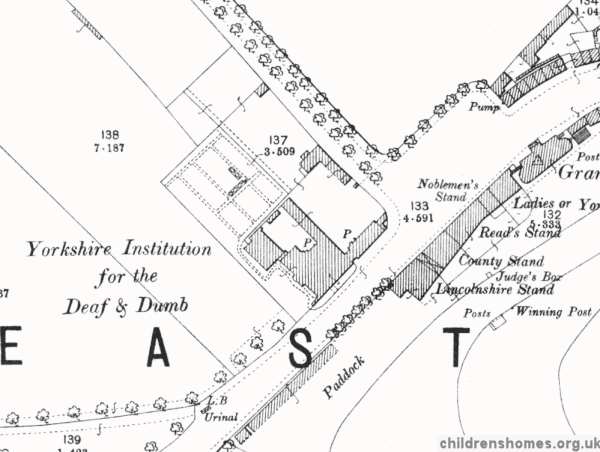
Yorkshire Institution for Deaf and Dumb Children site, Doncaster, c.1903.
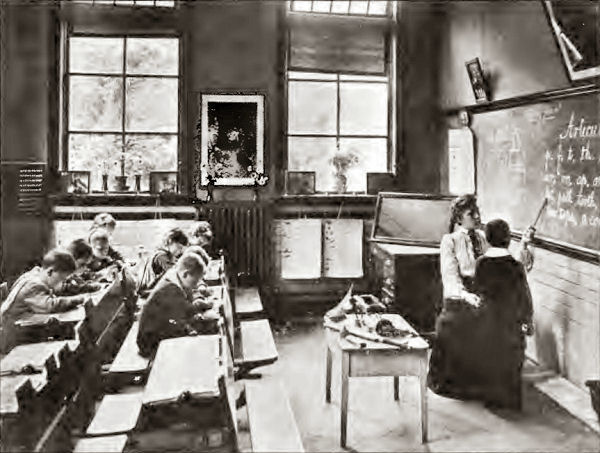
Yorkshire Institution for Deaf and Dumb Children, Doncaster, c.1907.
In April 1914, a preparatory school and a swimming bath were opened at the Institution. The swimming bath, measuring 42 feet by 21 feet, held about 25,000 gallons of water.
In November 1934, the corner stone was laid for the first phase of a completely new school at the west of the existing buildings. The initial section, providing accommodation for 86 girls, was opened by Lord Halifax on 25 September 1935. The corner stone for the larger second phase, which included accommodation for 80 boys, was laid in March 1939 and the completed building was opened the following year. The total cost of the scheme was £80,000, part of which had been met by selling the old Eastfield House buildings to Doncaster Council.
The School site in 1937 is shown on the map below.
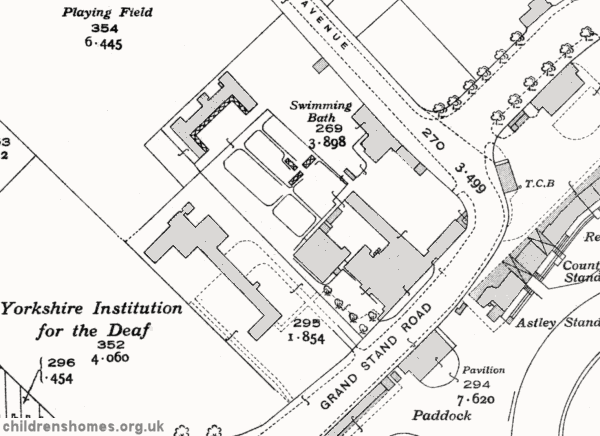
Yorkshire Institution for Deaf and Dumb Children site, Doncaster, c.1937.
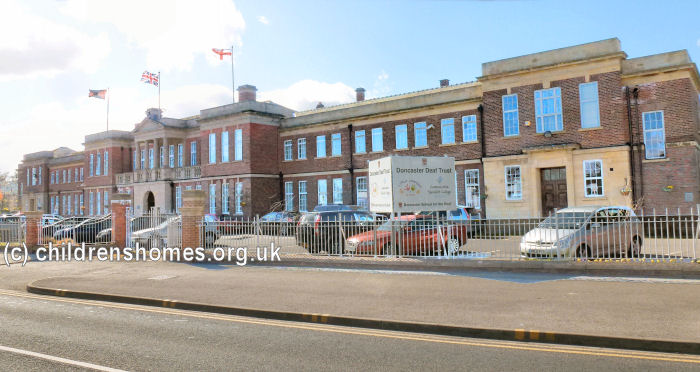
The 1930s buildings from the east, Yorkshire Institution for Deaf and Dumb Children, Doncaster, 2014. © Peter Higginbotham
From the 1940s, the Institution was known as the Yorkshire Residential School for the Deaf.
After the Second World War, Eastfield House was converted into flats for displaced families. It was subsequently demolished to allow a realignment of Grandstand Road.
The management body for the School is now known as the Doncaster Deaf Trust.
Headmasters
- 1829-1874 — Charles Baker
- 1874-1903 — James Howard
- 1904-1927 — George Greenslade
- 1927-1941 — David Craig
- 1941-1965 — Eric Greenaway
- 1965-1981 — Frank Hockenhull
Pupils
Records
Note: many repositories impose a closure period of up to 100 years for records identifying individuals. Before travelling a long distance, always check that the records you want to consult will be available.
- Doncaster Archives, King Edward Road, Balby, Doncaster DN4 0NA. Extensive holdings include: Committee minutes (1829-1947); Admission registers (1844-1905); Annual reports (1829-1966); Visitors' books (1829-1920); Teachers' records (1899-1961); School magazine (1946-79); Buildings (1837-1934); Pamphlets and publications 1854-1934.
Bibliography
- Boyce, Anthony J. The History of the Yorkshire Residential School for the Deaf 1829-1979 (1990, Doncaster Museums)
- Higginbotham, Peter Children's Homes: A History of Institutional Care for Britain's Young (2017, Pen & Sword)
- Pritchard, D.G., Education and the Handicapped 1760-1960 (1963, Routledge & Kegan Paul)
- Watson, J, Instruction of the Deaf and Dumb (1809)
- Watson, Thomas J., A History of Deaf Education in Scotland 1760-1939 (Unpublished PhD Thesis, University of Edinburgh, 1949)
Links
Except where indicated, this page () © Peter Higginbotham. Contents may not be reproduced without permission.


